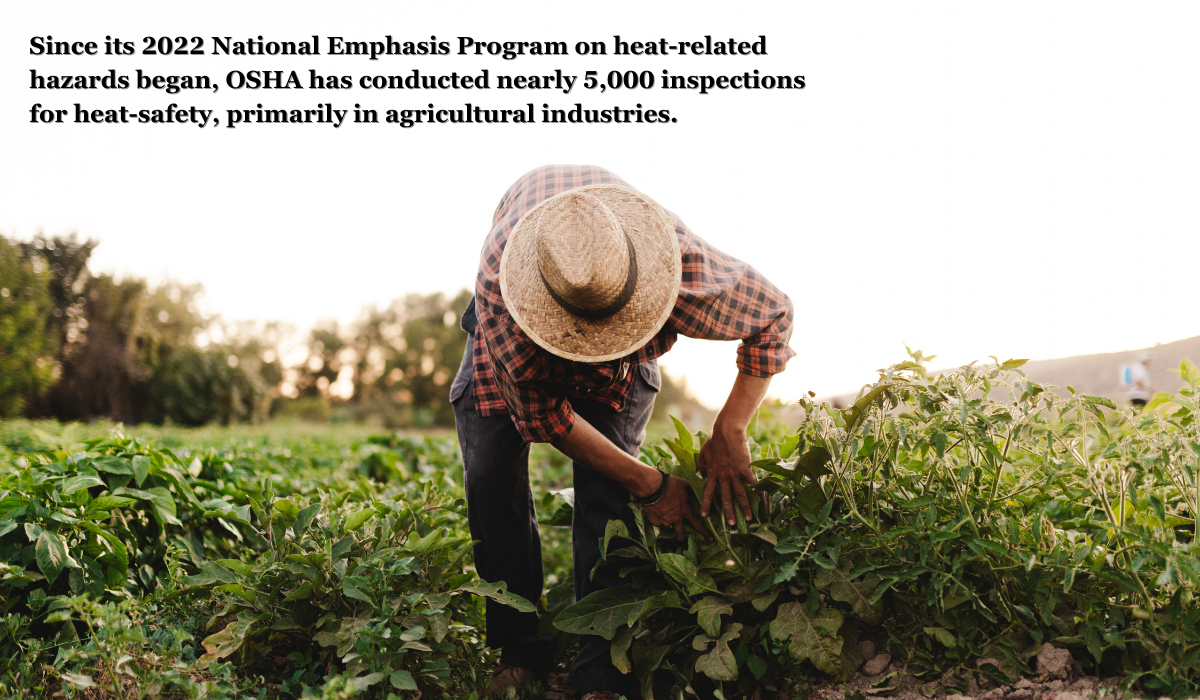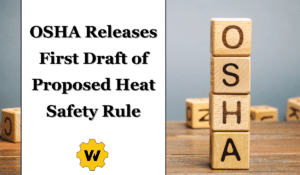Recently, the Department of Labor, through OSHA, took a major step in addressing the dangers of workplace heat exposure. In early July, 2024, they published the first, unofficial draft of a proposed heat safety standard aimed at reducing the health risks faced by U.S. workers in both outdoor and indoor settings.
That means an official standard, long sought by safety regulars, is one step closer to reality.
Prolonged exposure to high temperatures in the workplace can pose serious health risks. Heat stress can lead to heat exhaustion, heat stroke, and even death if not properly addressed. Workers engaged in physical labor, those without access to cooling mechanisms, and individuals with pre-existing medical conditions are particularly vulnerable.
Here, we’ll take a look at some of the details of the newly-proposed rule, and its implications for occupational health and safety.
Related Article: Dept. of Labor Advances Heat Safety Rulemaking, Intensifies Enforcement
Related Article: 5 PPE Items for Summer Heat Safety

OSHA’s Initiative and Regulatory Framework
On April 24, 2024, OSHA presented the initial regulatory framework of the draft rule at a meeting of the Advisory Committee on Construction Safety and Health. The committee unanimously recommended to proceed forward with the Notice of Proposed Rulemaking.
Then, in early July, OSHA publicly released the first draft of their proposed rule.
As we take a look at some of the details provided, it’s important to note that this preliminary draft is not yet official, and could change, as OSHA receives input from various stakeholders and the general public.
What Does OSHA’s Proposed Heat Safety Standard Look Like?
Currently, employers are legally obligated to protect workers from heat exposure only via OSHA’s “general duty” clause.
However, OSHA’s proposed heat safety rule takes things further, specifically addressing the dangers of heat illness. Here’s what OSHA currently has in mind:
Employer requirements under OSHA’s proposed heat standard would go into effect when the heat index in the work area reaches 80°F, or the wet bulb globe temperature (WBGT) is equal to the NIOSH Recommended Alert Limit (RAL).
These requirements include:
– Monitoring employees for heat stress
– Identifying heat hazards
– Providing water (1 quart per employee per hour) and rest break areas
– Implementing indoor work area controls
– Ensuring proper acclimatization of workers
– Issuing heat hazard alerts
– Maintaining personal protective equipment for heat
Additional requirements, known as the “high heat trigger,” would go into effect when the heat index reaches 90°F, or the WBGT is equal to NIOSH’s Recommended Exposure Limit (REL).
These include:
– Providing a minimum 15-minute paid rest break for employees every two hours
– Observing employees for signs and symptoms of heat illness
The heat index is a simple measure of how hot it feels based on air temperature and humidity, but it does not account for factors like direct sunlight, stagnant air, work clothing, and strenuous activities that can increase heat stress. WBGT is the recommended metric for assessing occupational heat stress as it incorporates air temperature, humidity, wind speed, and radiation.
Comprehensive heat stress prevention programs should also include worker training, acclimatization schedules, engineering and administrative controls, medical surveillance, and provision of water and shade.
Employers should consult occupational safety and health professionals to develop an effective heat stress management plan tailored to their workplace.
Current Efforts and Enforcement Measures
With the rulemaking process underway, OSHA continues to allocate significant resources towards outreach and enforcement activities, seeking to educate employers and workers about heat-related hazards.
The agency remains committed to enforcing OSHA’s general duty clause, as well as other relevant regulations, to hold businesses accountable for ensuring a safe work environment.
In addition to enforcing OSHA’s general duty, a National Emphasis Program on heat-related hazards was launched in 2022, focusing on proactive inspections in workplaces with high heat exposures to prevent injuries, illnesses, and fatalities.
Furthermore, the agency prioritizes inspections in agricultural industries that employ temporary H-2A workers. These workers remain particularly vulnerable to heat-related risks due to various factors such as language barriers and lack of acclimatization.
Since its inception, OSHA has conducted nearly 5,000 federal inspections related to heat hazards.
OSHA Will Seek Public Input
Of course, this is merely the first draft of OSHA’s proposed heat safety standard, and not yet official. As with any new rule, it must undergo a series of comment periods in which the public has an opportunity to make their voice heard.
OSHA encourages the public to participate by submitting comments when the proposed standard is officially published in the Federal Register. Your input will help develop the final rule that adequately protects workers, is feasible for employers, and is based on the best available evidence.
For information on how to provide comments at this stage of the process, you can visit OSHA’s page, right here.
Bringing It Together
For years, OSHA has sought a specific heat safety standard to protect workers’ health. Now, their proposed heat safety standard represents a significant stride towards that goal.
Employers have a responsibility to implement measures to protect workers, such as providing adequate hydration, rest breaks, and access to cooled environments. Recognizing the signs of heat stress and taking prompt action is crucial to safeguarding the health and well-being of employees in hot working conditions.
By addressing the risks associated with heat exposure and promoting proactive measures to protect workers, OSHA reinforces its commitment to ensuring a safe and healthy work environment for all.
Stay In Compliance With Worksite Medical
In most cases, OSHA requires medical surveillance testing, and at no cost to employees.
Worksite Medical makes that program easier with mobile medical testing.
With Worksite Medical, you get all the resources of a lab brought directly to your worksite, minimizing your workers’ downtime.
We’ll tailor a comprehensive medical surveillance program to your specific needs. Our services include silica exams, physical testing, heavy metal labs, PPE fit testing, x-rays, audiometric exams, drug & alcohol screenings, and much more. We safely maintain all of your team’s medical records, and provide you with quick access.
You’ll keep your employees at work, and stay ahead of OSHA inspections.
Protect your team and your workplace now with Worksite Medical. Not sure what you need? Try our medical testing wizard here.




